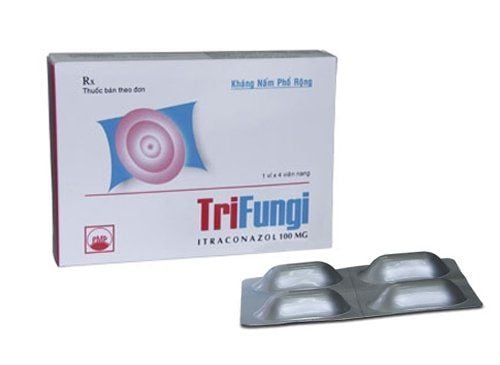This is an automatically translated article.
Miduc is a drug for the treatment of fungi that are sensitive to Azol antifungals. Let's learn about the uses and notes when using Miduc drugs through the article below.
1. What is Miduc?
Miduc drug has the main ingredient Itraconazole 100mg, hard capsule preparation.
Itraconazole is a synthetic triazol, which has better antifungal activity than Ketoconazole against some fungi, especially Aspergillus spp. It is also active against Coccidioides, Cryptococcus, Candida, Histoplasma, Blastomyces and Sporotrichosis spp. Itraconazole is an antifungal drug by inhibiting fungal cytochrome P450-dependent enzymes, thereby inhibiting ergosterol biosynthesis, causing membrane dysfunction and membrane-binding enzymes, affecting survival and growth. of fungal cells.
2. Uses of the drug Miduc
Miduc drug is indicated for use in the following cases:
Candidiasis in the mouth and throat. Ringworm, fungal skin infections such as tinea pedis, groin, hands. Toenail and foot fungus. Visceral fungal infections caused by Aspergillus and Candida, Cryptococcus, Histoplasma, Sporothrix, Paracoccidioides, Blastomyces. For maintenance therapy: In patients with AIDS to prevent recurrence of latent fungal infections. Prevention of fungal infections in patients during prolonged neutropenia. Miduc drug is not used in the following cases:
Hypersensitivity to the active ingredient Itraconazole and other Azols or to any ingredient of Miduc drug. Concomitant use of this drug with some antiarrhythmic drugs, lipid-lowering drugs of the HMG - CoA reductase inhibitor group. The patient is being treated with Terfenadin, Midazolam, Astemizole, Cisaprid, Triazolam orally. This drug should not be used in pregnant or lactating women, only when visceral fungal infection is life-threatening and when the potential benefit outweighs the risk of harm to the fetus or nursing infant. . Caution: Itraconazole should not be used in patients with congestive heart failure or history unless treating severe infections or life-threatening fungal infections.
3. Dosage and how to use Miduc
How to use: The drug is taken orally, should be taken immediately after eating.
Dosage: Depending on each case, the drug is used differently.
Vulvar - vaginal candidiasis: Take 2 tablets of Miduc 100mg / 2 times / day; or take 2 tablets / 1 time / day and use for 3 days. Ringworm: Take 2 tablets x 1 time/day for 7 days. Ringworm: Take 2 tablets x 1 time / day for 7 days or 1 tablet x 1 time / day for 15 days continuously. Highly keratinized areas such as fungal infections on the soles of the feet and hands: Take 2 tablets x 2 times/day for 7 days continuously or 1 tablet x 1 time/day for 30 days. Candida infections in the mouth or throat: Take 1 tablet x 1 time / day for 15 days. For people with AIDS, organ transplant or neutropenia: Take 2 tablets x 1 time/day for 15 days. Toenail fungus: Take the drug continuously 2-3 times, each session 7 days, take 4 tablets a day, 2 tablets in the morning, 2 tablets in the afternoon. Treatment sessions are always 3 weeks apart without medication. Or continuous treatment 2 tablets x 1 time / day for 3 months. Visceral fungal infections:
For Aspergillus infections: Take 2 tablets x 1 time / day, use for 2 to 5 months, if the disease is widespread, the dose can be increased to 2 tablets x 2 times / day. For Candida infection: Take 1-2 tablets x 1 time/day, use for 3 weeks to 7 months. Epidural Cryptococcus infections: Patients take 2 tablets x 1 time/day for 2 months to 1 year. Cryptococcal meningitis: Take 2 tablets x 2 times/day. Maintenance treatment take 2 tablets x 1 time / day. Histoplasma infection: Take 2 tablets x 1-2 times/day, the average duration of use is 8 months. Sporothrix schenckii infection: You should take 1 tablet x 1 time / day, use for 3 months. Infection with Paracoccidioides brasiliensis: Take 1 tablet x 1 time/day, use continuously for 6 months. Chromomycosis (Cladosporium, Fonsecaea): Take 1-2 tablets x 1 time/day, use continuously for 6 months. Blastomyces dermatitidis infection: Take 1 tablet x 1 time/day or 2 tablets x 2 times/day, use within 6 months.
4. Side effects of the drug Miduc
When taking the drug you may experience some side effects including:
Common side effects that can occur are nausea, abdominal pain, headache and indigestion. Rare side effects: Possible allergic reactions such as itching, rash, urticaria and angioedema, menstrual disorders, reversible elevation of liver enzymes, Stevens-Johnson syndrome. Very rarely, hypokalemia.
5. Things to pay attention to when taking Miduc
This is a prescription drug, used under a doctor's prescription, you do not arbitrarily use the drug. Before taking the medicine, you need to tell your doctor about your history of allergies, diseases and medications you are taking to avoid combining drugs that have the potential to harm the body.
In systemic candidiasis suspected to be caused by Fluconazole-resistant Candida, this strain may also be insensitive to Itraconazole. Therefore, itraconazole should be tested for sensitivity before treatment.
Use with caution in people with a history of liver disease or liver toxicity by other drugs.
When taking the drug for a long time (i.e. taking it for more than 30 days), regular liver function tests should be performed.
Because Itraconazole can cause harm to an unborn baby. Effective contraception should be used while taking the drug and contraception for at least 2 months after the last dose of this antifungal medication.
Storage: You should store the medicine in a cool place, away from direct sunlight. Keep out of reach of children.
Miduc drug is used to treat fungal infections, can be used for a long time with necessary cases. To ensure safety for your health and maximize the effectiveness of your treatment, you need to take Miduc exactly as directed by your doctor.
Please dial HOTLINE for more information or register for an appointment HERE. Download MyVinmec app to make appointments faster and to manage your bookings easily.













